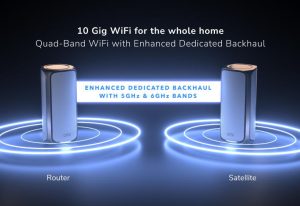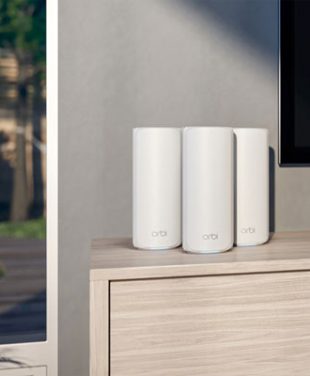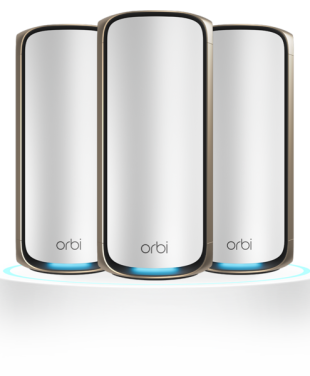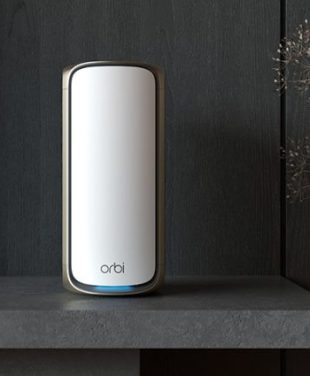Orbi add-on Satellites work in tandem with your existing Orbi Router System to boost and extend WiFi coverage and eliminate dead zones. Easily monitor connection status with the NETGEAR Orbi satellite LEDs and experience unmatched WiFi coverage and connectivity in your home or office network.
IN THIS ARTICLE
- Can I Extend the WiFi Range with Add-On Orbi Satellites?
- Orbi Satellite Placement and Orbi LED Lights
- How Many Orbi Satellites Do I Need?
- Troubleshooting Steps for the Orbi Router LED Lights
- Troubleshooting Steps for the Orbi Satellite Ring LED Lights
- What is Orbi WiFi Backhaul and Ethernet Backhaul?
- How Do Orbi Satellites Make A Difference?
Can I Extend the WiFi Range with Add-On Orbi Satellites?
NETGEAR Orbi whole-home mesh WiFi systems are transforming homes and businesses nationwide. The strategically placed Orbi satellite nodes communicate directly with each other and with your main router access point. Connection is effortless, allowing you to roam from one room to another without needing to reconnect to the internet. With Orbi satellite nodes, the WiFi range can be extended upstairs, downstairs, and even out in the backyard. Orbi satellites redefine connectivity norms and deliver genuine multi-gigabit WiFi speeds for 200+ connected devices and smart home applications running concurrently.
Orbi Satellite Compatibility
Orbi mesh systems are preconfigured with 1 or more Orbi satellites specifically tuned with factory default settings to sync with the Orbi router. Additional Satellites can be added at any time to extend the range of an Orbi mesh WiFi system. For optimal system performance, choose add-on satellites that are compatible with your Orbi router series.
The first two digits of the Orbi router model number indicate the series number. For example, the Orbi system RBKE963 is from the Orbi 960 series and is designed to work with 960 Series add-on satellites. You can also check your model number on the bottom of the router unit or match the model number with your existing satellites.
Orbi satellites may only be used with a compatible Orbi router system. Orbi satellites are not designed to function as a standalone WiFi extender. If you are considering upgrading to the latest WiFi mesh system, explore our Orbi Buyer’s Guide for inspiration.
Orbi Satellite Placement and Orbi LED Lights
Orbi satellite nodes are optimized with powerful antennas that provide 360-degree WiFi coverage. They are also attractive decor units that look great on a side table or mantle shelf. You will need to consider your home or office layout to determine the ideal distance between your Orbi satellites and your main Orbi router, and the Orbi satellites will need to be plugged into an existing power source. To establish a good connection, you should avoid the need for WiFi signals to travel through brick walls or other solid surfaces.
As a rough guide, one Orbi unit per 4-5 rooms is usually sufficient to deliver blazing-fast WiFi coverage. To make the NETGEAR Orbi mesh system setup and monitoring hassle-free for the average internet user, the satellites include LED status lights. You can easily check your Orbi mesh system by referring to the satellite power and ring LED status light color as follows:
- Solid Blue Light: Your Orbi Satellite connection strength is optimal.
- Solid Amber Light: Weak signal – move the satellite closer to your router.
- Pulsing Amber: A factory reset is in progress, or a firmware update is being applied.
- Pulsing Magenta: No connection to the Orbi Network found – Move your satellite closer.
- Solid Magenta: Your Orbi satellite has no backhaul internet connection or it has no IP address.
- Flashing White Light: Standby – firmware or configuration update in progress.
- Blinking Red: This could indicate a system error or a need for troubleshooting.
How Many Orbi Satellites Do I Need?
WiFi satellites are in some ways similar to range extenders. However, with Orbi satellite mesh WiFi systems, you will only need a single Orbi login password for your entire network. The entire Orbi WiFi network can be set up in less than 30 minutes, even if you are a first-time user. Booting is straightforward using the Orbi app or user manual, and you can add as many satellites as needed to optimize your Orbi WiFi 6 or WiFi 7 local area network (LAN) or wide area network (WAN). Here are some key considerations when deciding how many satellites you might need.
- Space Size – Assess the square footage of your home or office. Larger spaces generally require more satellites to ensure comprehensive coverage.
- Coverage Goals – Decide if you want seamless coverage throughout the entire space or if you’re targeting specific areas with weak signals.
- Signal Strength – Identify rooms or zones where the signal is weak or inconsistent. These are the areas where you’ll need targeted satellite coverage.
- Building Layout – Consider architectural elements like walls, floors, and obstacles that can impact the wireless signal. Thick walls or multiple floors might necessitate extra satellites.
- Device Density – Estimate the number of devices that will be connecting to the network within different areas. More devices require stronger coverage.
- Bandwidth Requirements – Determine the intensity of data usage in different areas. Activities like HD streaming and multi-user gaming demand higher bandwidth and closer satellite placement.
- Tri-Band and Quad-Band Satellites – Tri-band and quad-band satellites have a dedicated backhaul channel. Consider how many devices will benefit from this added bandwidth.
- Future Expansion – Think about future-proofing your network. If you plan to add more devices or expand your space, having extra satellites can accommodate growth.
- Specific Orbi Satellite Model – Each Orbi satellite model has specific coverage capacities. Check the specifications of your chosen model to gauge its range.
- Mesh Topology – Plan the positioning of satellites to create an effective mesh network. Proper placement enhances coverage and minimizes signal interference.
- Performance Expectations – Define the quality of WiFi signals you expect in each area. High-performance busy zones like living rooms might require closer satellite placement.
By considering these factors, you can accurately determine the number of Orbi satellites needed to achieve optimal coverage and performance in your network.

Troubleshooting Steps for the Orbi Router LED Lights
The Orbi router LED lights are important for troubleshooting if there are network issues. Understanding what the various colors indicate is part of good network management. To troubleshoot LED lights on your router, follow these steps.
Step 1: Check the power LED light. If it’s solid green, the router is powered up and working. No light or a blinking light means check the plug and reset.
Step 2: Look at the internet LED light. White means success. If it is not lit or is flashing, you should check the modem connection or contact your ISP for guidance.
Step 3: Examine the LAN port LED lights. Green is an active Ethernet connection. Amber is a slower Gigabit connection. If there is no light, check the Ethernet cables.
Step 4: Monitor the WiFi LED lights. White is a working WiFi network and amber or blinking white signals a connectivity issue. Make sure your device is close enough to the router and reboot if required.
Troubleshooting Steps for the Orbi Satellite Ring LED Lights
To troubleshoot the satellite LED lights on the Orbi system, follow these steps.
Step 1: Check the Power LED: The Power LED should be solid green. If it’s not lit or is blinking, there could be a power problem. Make sure the satellite is connected to a power source.
Step 2: Verify Connection with the router: The Connection LED should be solid white if it’s connected to the Orbi router. It will be pulsing white while powering up. If it’s amber or off, there may be a connection issue. Check that the router and satellite are switched on and are close enough for a strong signal.
Step 3: Monitor the Sync Status: The Sync LED shows the sync between the satellite and the router. The Sync LED should be solid blue for optimal performance. If it’s purple or off, there may be a syncing issue. Reboot the router and satellite.
Step 4: Address Other Connectivity Issues. If all previous steps are fine, but you still have connection issues, look at the Orbi user manual or online Orbi app support resources for help specific to your situation. Contact NETGEAR Support for more information.
For Sync buttons on the Orbi router and satellite, visit How do I sync my Orbi router and satellite?
What is Orbi WiFi Backhaul and Ethernet Backhaul?
Orbi satellites and the Orbi router seamlessly connect through a dedicated WiFi backhaul connection. WiFi backhaul is a fast and convenient way to connect Orbi devices. In certain situations, it might be desirable to use a wired Ethernet cable backhaul connection between the router and satellites. This method can be preferable in distant rooms such as the garage or basement. If existing Ethernet wiring infrastructure is available, wired Ethernet backhaul can be enabled in the Orbi App.
The Orbi App is used for Orbi system setup, running speed tests, firmware updates, and many other convenient functions such as parental controls and NETGEAR Armor Security.

How Do Orbi Satellites Make A Difference?
From expanding WiFi coverage to eliminating dead zones, each Orbi Satellite is designed to transform your network experience. Whether you’re a homeowner or a business owner demanding reliable connections and seamless streaming, Orbi offers solutions that are tailored to your needs. Orbi satellites will redefine the way you connect, communicate, and create. Choose the right Orbi satellite for your space and take a quantum leap into the future of networking.






